Singapore Top Green Buildings
Singapore has become a global leader in sustainable architecture and eco-friendly building practices. With a focus on green initiatives and a commitment to environmental sustainability, the city-state is home to some of the most impressive and innovative green buildings in the world. From skyscrapers covered in living plants to energy-efficient designs, Singapore’s top green buildings are pushing the boundaries of sustainable construction. Let’s explore the architectural wonders that have made Singapore a showcase for green building technologies.
Key Takeaways:
- Singapore is a global leader in sustainable architecture and eco-friendly building practices.
- The city-state is home to some of the most impressive and innovative green buildings in the world.
- Green buildings in Singapore incorporate technologies and designs that promote environmental sustainability.
- Sustainable construction practices are integral to Singapore’s commitment to a greener future.
- The architectural wonders in Singapore showcase the possibilities of sustainable design and construction.
The Oasia Hotel Downtown by WOHA
The Oasia Hotel Downtown, designed by WOHA and completed in 2016, is a stunning example of sustainable design in Singapore. The entire 27-floor external facade is wrapped in a natural vine-covered sunscreen, providing shade and reducing the need for air conditioning. The hotel also features four lush sky terraces, 1,793 large planter boxes, and four large structural cores that allow for good cross ventilation, further reducing the overall energy cost. With over 33 species of plants and 21 species of creepers, the Oasia Hotel Downtown seamlessly integrates green architecture into its design.
Throughout the hotel, guests are greeted by a refreshing sense of nature, with greenery adorning the walls and large windows that provide ample natural light. The incorporation of plant-filled terraces throughout the building not only enhances the aesthetics but also helps to lower ambient temperatures and improve indoor air quality.
The Oasia Hotel Downtown has become a landmark in sustainable hospitality, setting a new standard for energy-efficient and environmentally-friendly hotels in Singapore. Its commitment to sustainable design and green architecture not only creates a pleasant and inviting space for guests but also serves as a testament to Singapore’s dedication to sustainability.
Located in the heart of Singapore’s bustling city center, the Oasia Hotel Downtown proves that sustainable design can coexist with modern urbanity. Its energy-efficient features and harmonious integration of green architecture make it a model for future sustainable developments. For travellers seeking a unique and eco-conscious experience, the Oasia Hotel Downtown by WOHA is a perfect choice.
Gardens by the Bay by Wilkinson Eyre
Gardens by the Bay, designed by Wilkinson Eyre and opened in 2011, is a world-renowned attraction known for its sustainable design and use of green technology. Spanning over 250 acres, these gardens showcase eco-friendly developments in Singapore and provide a stunning example of sustainable design in action.
The highlight of Gardens by the Bay is its two massive conservatories, the Flower Dome and the Cloud Forest. These conservatories are the largest climate-controlled greenhouses in the world, showcasing diverse collections of plants and flowers from various regions.
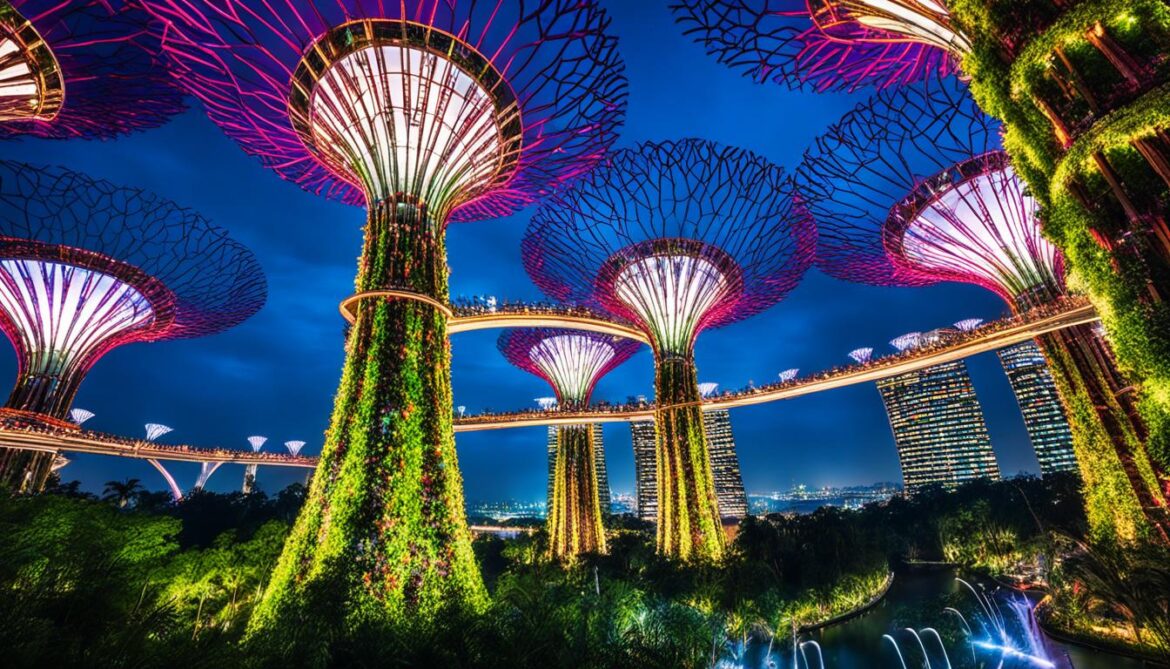
Another iconic feature of Gardens by the Bay is the Supertrees. These towering tree-like structures, standing at heights of up to 50 meters, serve both as vertical gardens and as environmental engines. Incorporating innovative green technology, the Supertrees are equipped with photovoltaic systems that harness solar energy for self-sufficiency. They also have cooling channels within their structure to moderate the surrounding climate and conserve energy.
As an eco-friendly development, the Supertrees play an essential role in the sustainability of Gardens by the Bay. They support a vast array of living flora, with more than 1.5 million plants comprising their skin. This integration of plant life further enhances the environmental impact of the Supertrees and showcases the commitment to sustainable design.
“Gardens by the Bay is a testament to the possibilities of sustainable architecture and green technology. Through its innovative design and incorporation of natural elements, this iconic attraction has become a symbol of Singapore’s commitment to environmental sustainability.”
The gardens themselves are meticulously landscaped and include themed areas such as the Heritage Gardens and the Dragonfly Lake. These areas not only provide visitors with a tranquil escape from the city but also serve as habitats for a diverse range of flora and fauna, contributing to the overall biodiversity of the Gardens by the Bay.
With its combination of sustainable design, green technology, and breathtaking landscapes, Gardens by the Bay stands as a shining example of eco-friendly development in Singapore. It serves as an inspiration for future sustainable construction projects and underscores the city-state’s dedication to creating a greener and more sustainable future.
Parkroyal on Pickering by WOHA
Parkroyal on Pickering, designed by WOHA and completed in 2013, is an exceptional example of sustainable construction practices in Singapore. The hotel incorporates various green design elements, including rain sensors, solar power, and water-conservation measures. It also features 161,459 square feet of sky gardens, waterfalls, and planter walls, constituting more than twice its total land area. This integration of nature into the design not only enhances the aesthetics but also contributes to the overall sustainability of the building.

| Green Design Elements | Benefits |
|---|---|
| Rain sensors | Optimize water usage and reduce wastage |
| Solar power | Generate renewable energy and reduce reliance on non-renewable sources |
| Water-conservation measures | Minimize water consumption and promote water conservation |
| Sky gardens, waterfalls, and planter walls | Enhance the building’s aesthetics and provide green spaces for relaxation and recreation |
The sustainable construction practices implemented in Parkroyal on Pickering demonstrate the hotel’s commitment to environmental stewardship and its contribution to the green design and construction movement in Singapore.
National Gallery Singapore by studioMilou in collaboration with CPG Consultants
The National Gallery Singapore is a striking testament to the seamless integration of art, heritage, and sustainability. Designed by studioMilou in collaboration with CPG Consultants, this LEED-certified building showcases Singapore’s commitment to creating sustainable future cities.
Covering an impressive 690,000 square feet, the National Gallery Singapore is housed within the iconic former City Hall and Supreme Court buildings. These historic structures have been revitalized and transformed into a vibrant art space that preserves Singapore’s rich heritage while embracing forward-thinking design principles.
One of the standout features of the National Gallery Singapore is its innovative canopy with a tree-like structure. This canopy not only adds a touch of architectural elegance but also serves a functional purpose. It softens and filters the natural light that enters the building, creating a pleasant and inviting ambiance for visitors.
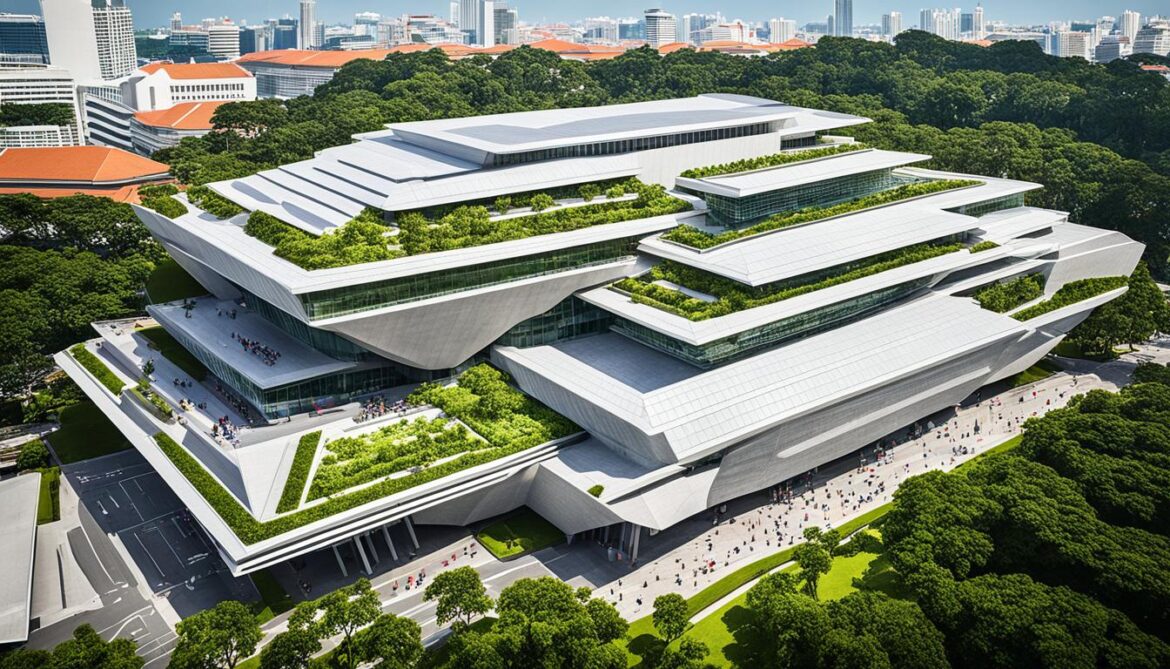
The National Gallery Singapore also incorporates glass atriums that encase the courtyards. These atriums allow an abundant amount of natural light to filter through, creating a harmonious interplay between the indoors and outdoors. The reflective pools on the rooftop level further enhance this relationship while helping to keep temperatures down, reducing the need for excessive air-conditioning.
As a LEED-certified building, the National Gallery Singapore exemplifies sustainable design and construction practices. With its adaptive reuse of existing structures, energy-efficient features, and commitment to preserving the environment, it stands as an inspiring example of how art and sustainability can come together to shape a better future.
Asia Square by Denton Corker Marshall
Asia Square, designed by Denton Corker Marshall and opened in 2011, is widely recognized as one of the greenest retail and office buildings in Singapore. The 43-story tower, which is also home to The Westin Singapore, consumes 35 percent less energy than standard commercial buildings. This impressive energy efficiency is achieved through innovative design features, such as the conversion of kinetic energy from elevators back into electrical energy. The building also incorporates water and vapor droplet collection systems for irrigation purposes and an on-site biodiesel plant for electricity generation.
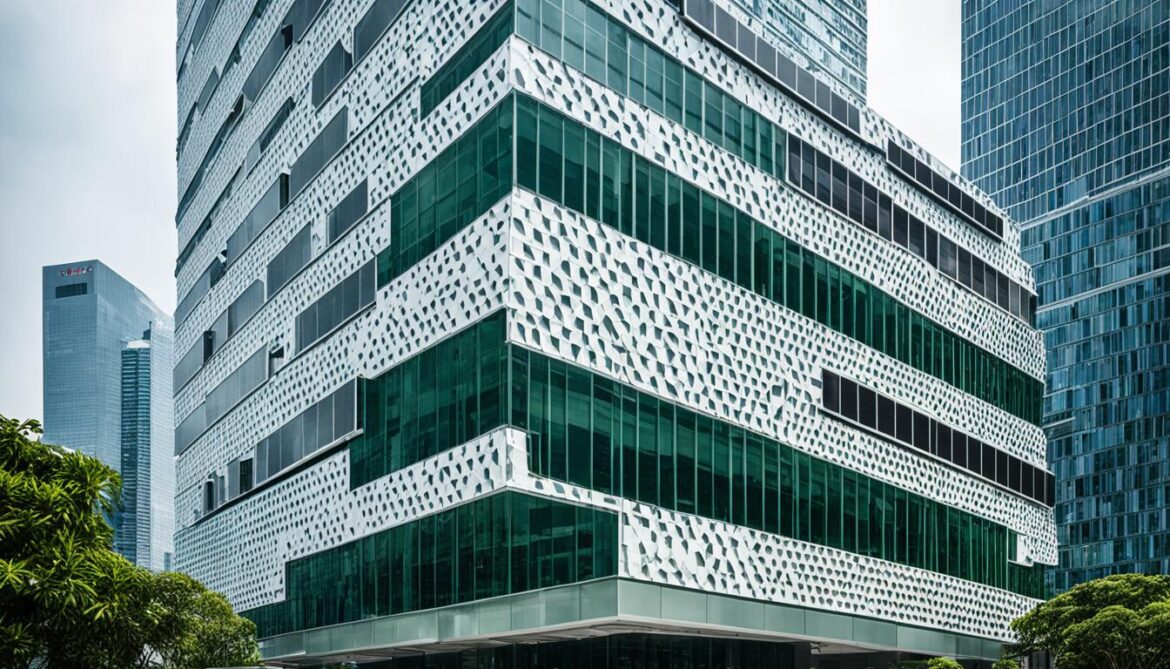
CapitaGreen by Toyo Ito & Associates
CapitaGreen, designed by Pritzker Prize winner Toyo Ito, is a standout example of green building technologies in Singapore. Completed in 2014, this impressive 40-story office tower incorporates innovative sustainable construction practices to create a modern and environmentally-friendly urban landscape.
The building’s design features a double-skin facade, comprising of an outer layer of frameless glass and an inner envelope of double-glazed, full-height glass. This architectural innovation effectively reduces solar heat gain and acts as a greenhouse for plants, allowing them to thrive within the building.
CapitaGreen also integrates natural elements through its incorporation of four sky terraces. These beautifully landscaped terraces bring nature indoors, providing occupants with a refreshing and green environment.
Another notable feature is the implementation of a wind scoop that takes advantage of the prevailing wind direction. This strategic design element draws in cooler and cleaner air, enhancing ventilation within the building and reducing the need for artificial cooling.
CapitaGreen’s commitment to sustainable construction practices makes it a prime example of Singapore’s dedication to green building technologies. By seamlessly integrating nature and utilizing renewable energy sources, this architectural marvel sets the benchmark for sustainable development in the city and beyond.

Kampung Admiralty by WOHA
Kampung Admiralty, designed by WOHA and named World Building of the Year in 2018, is a groundbreaking project that showcases sustainable design and environmentally-friendly practices. This mixed-use public facility features multiple layers of functions, with a community plaza on the ground level, a healthcare facility in the middle stratum, and senior housing on the upper floors and rooftop. The building’s roofscape is notable for its staggered terraces filled with lush plants, creating a community park-like environment. Kampung Admiralty is a shining example of thoughtful sustainable design in Singapore.
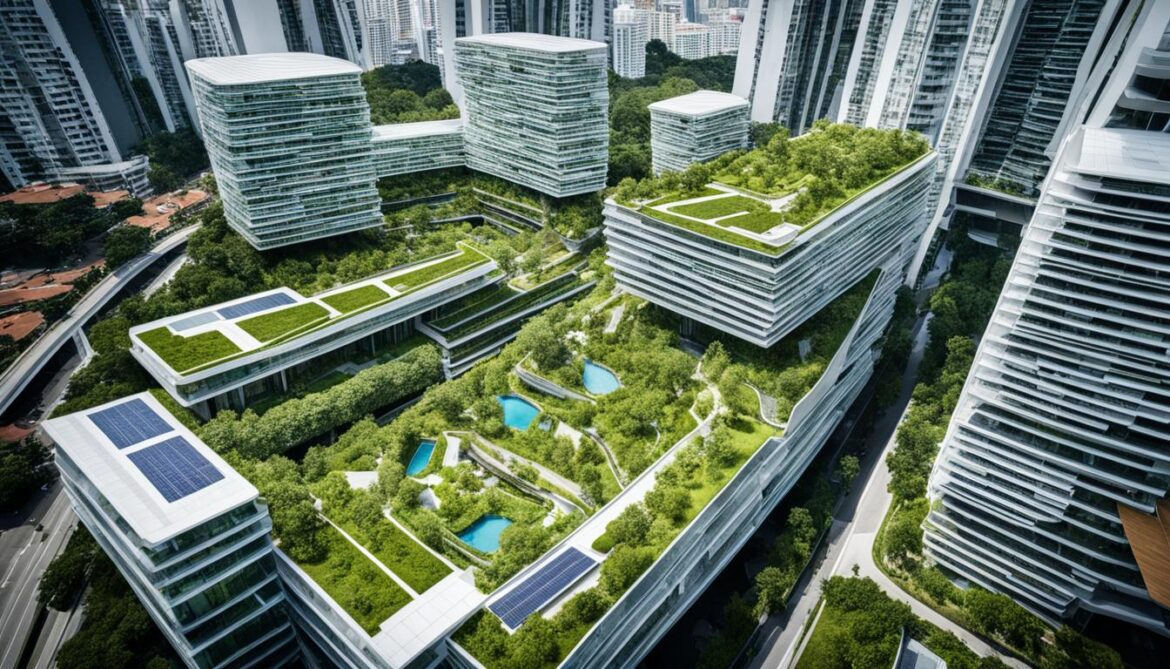
Kampung Admiralty by WOHA is a remarkable achievement in sustainable design and environmentally-friendly developments in Singapore. This innovative mixed-use facility embodies the concepts of community, health, and sustainable living. The integration of various functions within the building, such as the community plaza, healthcare facility, and senior housing, offers a holistic approach to urban living.
One of the standout features of Kampung Admiralty is its roofscape, which is designed with staggered terraces filled with lush plants. This not only enhances the aesthetics of the building but also creates a vibrant green environment for the residents and visitors. The incorporation of green spaces not only promotes a sense of well-being but also contributes to the overall sustainability of the development.
By integrating multiple layers of functions and prioritizing sustainable design principles, Kampung Admiralty sets a new standard for environmentally-friendly developments in Singapore. It serves as a model for future projects, demonstrating the possibilities of creating sustainable and livable communities within an urban environment.
Nanyang Technology University School of Art, Design and Media by CPG Consultants
The Nanyang Technology University School of Art, Design and Media, designed by CPG Consultants, is an exemplary showcase of sustainable architecture in Singapore. This innovative building incorporates sustainable design principles to create an environment that is both visually stunning and environmentally friendly.
The key feature of this building is its green roof, which slopes at almost a 45-degree angle. The green roof serves multiple purposes, including reducing roof and ambient temperatures and minimizing heat gain. By using natural vegetation as a protective layer, the building remains cooler, reducing the need for excessive air conditioning. The sloping design of the roof also allows rainwater to be naturally collected and reused for irrigation purposes, reducing the reliance on traditional water sources.
In addition to the green roof, the Nanyang Technology University School of Art, Design and Media incorporates a courtyard filled with water features and plants. This not only creates a peaceful and tranquil environment for students but also enhances the overall sustainability of the building. The plants help to filter the air, improving its quality, while the water features provide a cooling effect, reducing the need for additional air conditioning.
By integrating these sustainable design elements, the Nanyang Technology University School of Art, Design and Media demonstrates its commitment to green design and construction practices. The building not only provides a space for creativity and innovation but also serves as a model for sustainable architecture in Singapore.
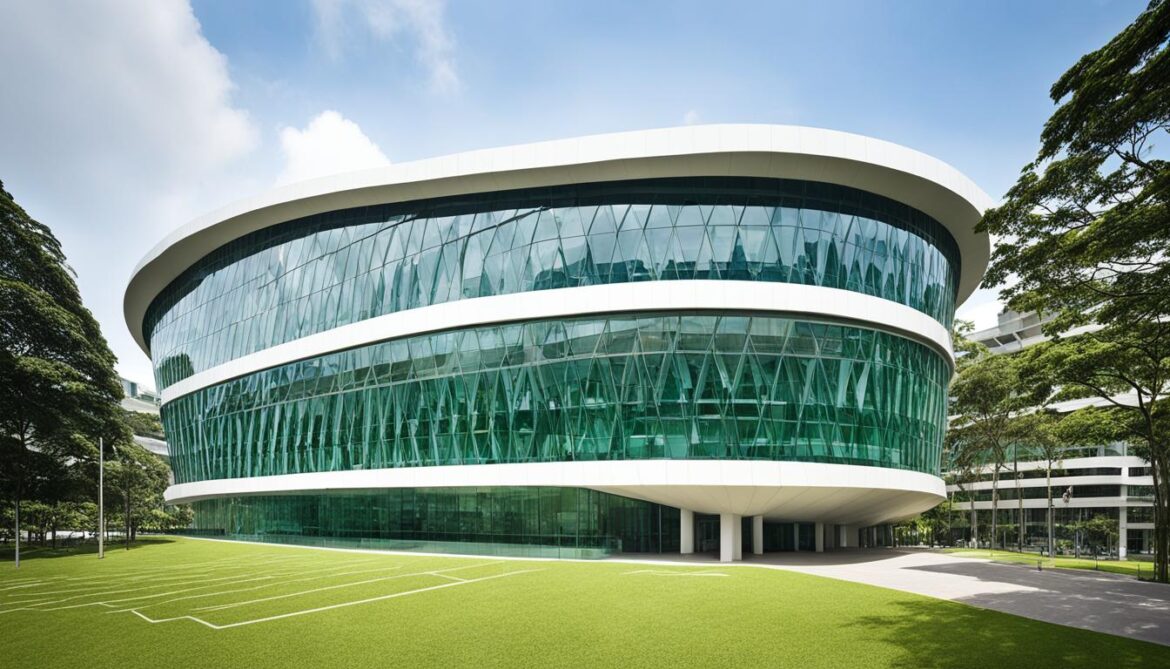
Key Features:
- Green roof that reduces roof and ambient temperatures
- Courtyard with water features and plants for a relaxing environment
- Natural ventilation and reduced reliance on air conditioning
- Integration of rainwater collection for irrigation purposes
“The Nanyang Technology University School of Art, Design and Media is a testament to the possibilities of sustainable architecture in Singapore. Through its thoughtful design and incorporation of green elements, this building sets a new standard for environmentally friendly construction.”
With its dedication to sustainable design and construction, the Nanyang Technology University School of Art, Design and Media highlights the importance of green building practices. This iconic structure serves as a shining example of how sustainability can be seamlessly integrated into the architectural landscape of Singapore, creating a more eco-friendly and sustainable future.
Conclusion
Singapore has emerged as a global leader in sustainable architecture and eco-friendly buildings, showcasing its commitment to green building technologies. Through notable examples like the Oasia Hotel Downtown, Nanyang Technology University School of Art, Design and Media, and many others, Singapore has demonstrated its innovative and environmentally conscious approach to construction.
These remarkable green buildings not only enhance Singapore’s aesthetic appeal but also serve as inspiring models for sustainable design and construction practices. By integrating sustainable architecture into its urban landscape, Singapore continues to lead the way in creating a sustainable and environmentally-friendly built environment.
The city-state’s focus on sustainable architecture in Singapore, along with the development of eco-friendly buildings, plays a pivotal role in reducing carbon emissions and mitigating the impact of urbanization on the environment. As Singapore perseveres in its efforts to create a greener and more sustainable city, it serves as an inspiration to cities worldwide.
FAQ
What are some examples of sustainable architecture in Singapore?
Why is sustainable design important?
What are some green building technologies used in Singapore?
How do green buildings contribute to sustainability?
What certifications are available for green buildings in Singapore?
How are green buildings contributing to the overall sustainability of Singapore?
What is the future of sustainable design and construction in Singapore?
How can individuals and businesses contribute to sustainable construction practices?
Source Links
- https://www.visitsingapore.com/travel-guide-tips/about-singapore/city-in-nature/sustainable-architecture/
- https://interiordesign.net/projects/8-sustainably-designed-and-architecturally-significant-buildings-in-singapore/
- https://www.timeout.com/singapore/things-to-do/the-most-stunning-green-architecture-in-singapore





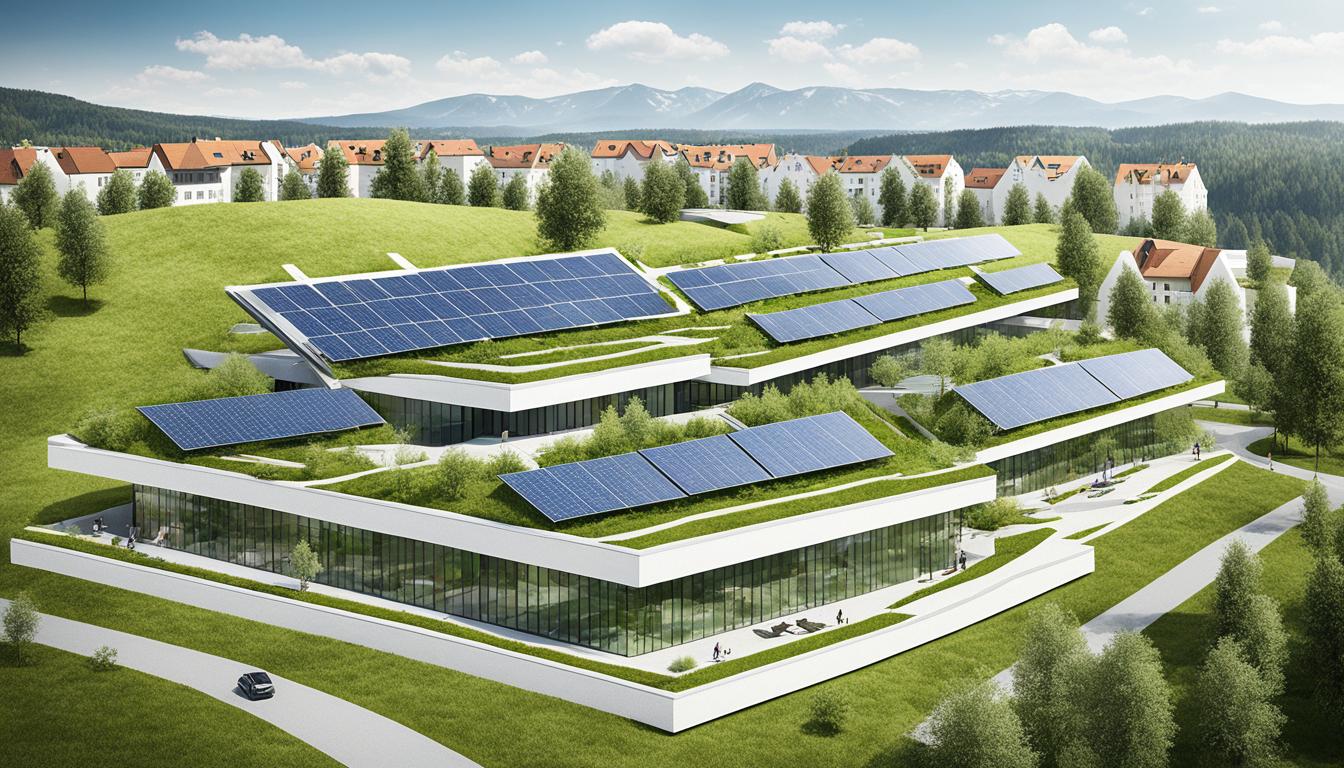
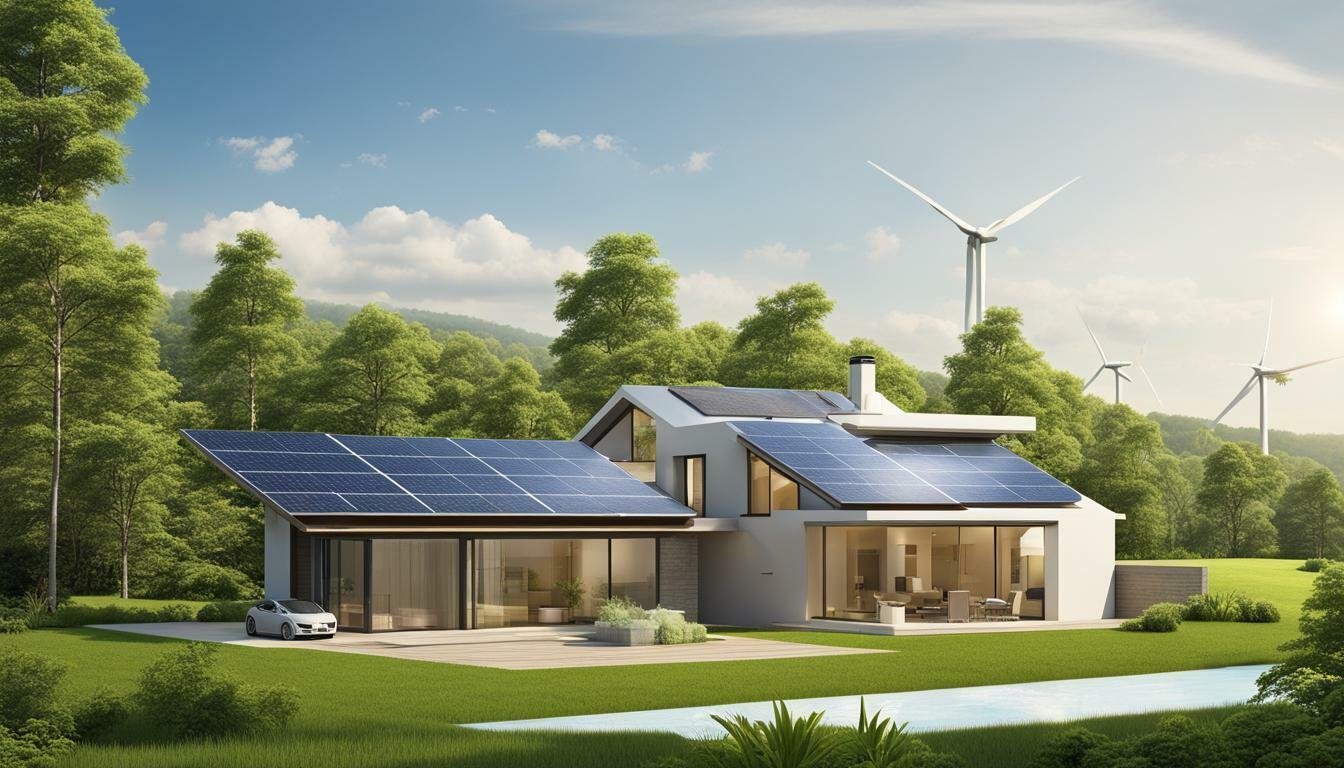
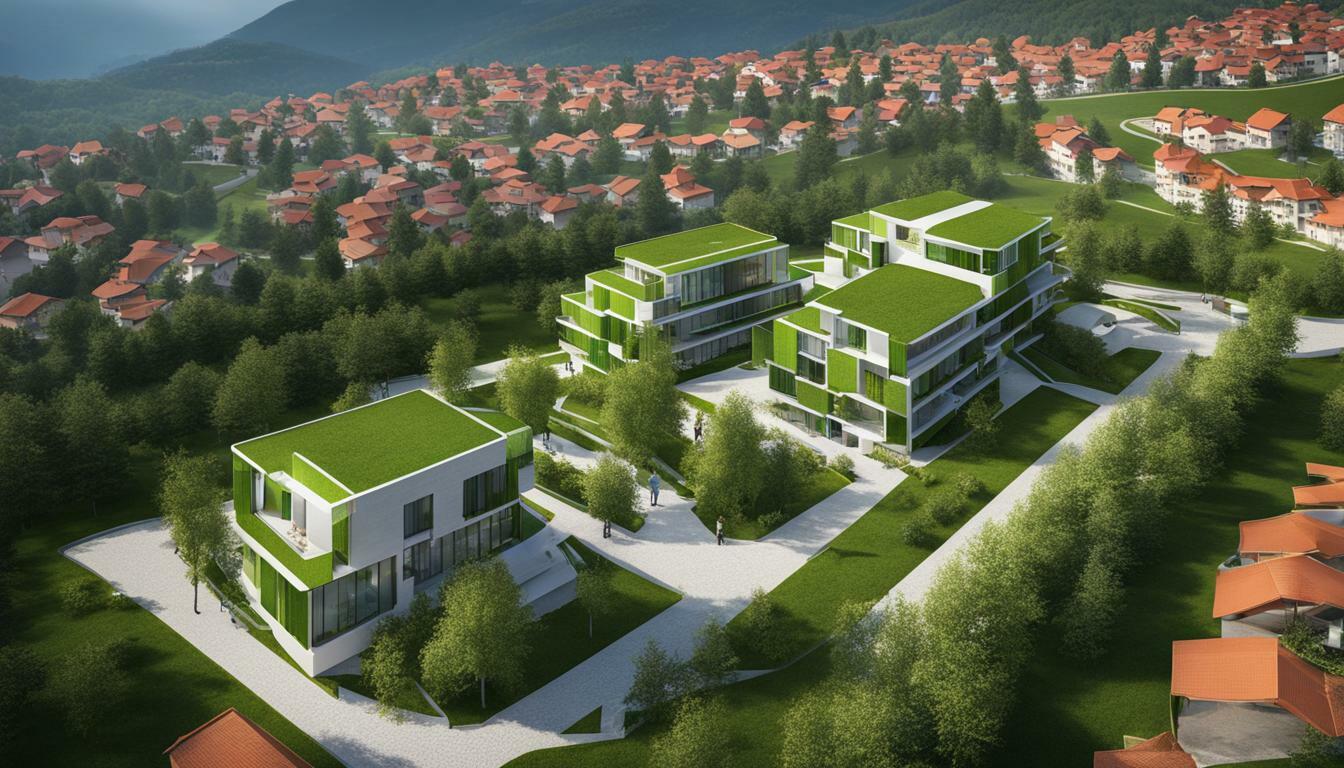

Step into the Mystical Cloud Forest: Singapore’s Lush Oasis in the Sky – imaexplorer
7 months ago[…] with Singapore’s vision as a leader in green building innovation, as highlighted in the Singapore Top Green Buildings […]